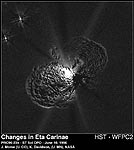|
|
Eta Carinae in Context
 Superposition of two optical images
taken 17 months apart. Black: Apr '94; White: Sep
'95 Superposition of two optical images
taken 17 months apart. Black: Apr '94; White: Sep
'95
Photo: NASA/HST/J. Morse/K. Davidson
|
Eta Carinae is one of the most enigmatic and intriguing objects
in our galaxy. Between 1837 and 1856 it increased dramatically
in brightness to become the brightest star in the sky except for
Sirius, even though it is 7,500 light years away, more than
eight hundred times the distance to Sirius.
This "Great Eruption," as it is called, is thought to have been
caused by internal radiation pressure in the massive star that
somehow triggered an instability, or by interaction with a
nearby companion star. After the Great Eruption, Eta Carinae
faded to become a dim star, invisible to the naked eye. Since
1940, it has begun to brighten again, becoming visible to the
naked eye.
Modern day observations of Eta Carinae have shown it to be the
most luminous object known in our galaxy. It radiates at the
rate of several million times that of the Sun. Most of the
radiation is at infrared wavelengths, from dust in the bipolar
nebula. Astronomers still do not know what lies at the heart of
Eta Carinae. Most believe that it is powered by an extremely
massive star which may have a companion.
 X-ray image of ETA
CARINAE X-ray image of ETA
CARINAE
NASA/CXC/SAO
|
Eta Carinae may be an extreme example of a luminous blue variable-a critical
stage in the evolution of the most massive stars. Such a star can produce
intense amounts of radiation that causes violent instabilities before
it explodes as a supernova, or even possibly a "hypernova," a type of
super-supernova explosion that has been hypothesized to produce gamma
ray bursts.
The Chandra X-ray image gives an important glimpse deep into the nebula
where the fastest material being thrown off by Eta Carinae is found. The
outer ring provides evidence of another large explosion that occurred
over a thousand years ago. Further Chandra observations of Eta Carina
are planned for the near future and should give astronomers deeper insight
into this cryptic colossus.
Return to Eta Carinae (08
Oct 99)
|